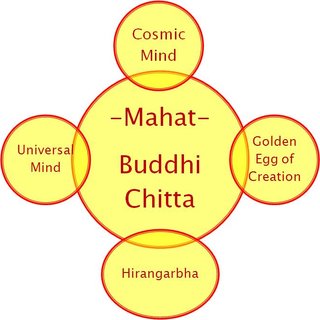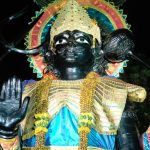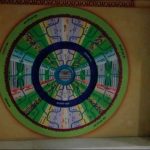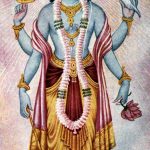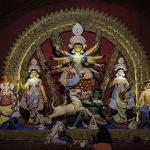Sankhya philosophy is one of the six theories of darshan or the way of looking or interpreting human life on earth. It is the oldest philosophy out of the six darshans because the doctrines of Sankhya are found in Mahabharata, Ramayan, and even in Bhagavad Gita. There are numbers of Vedas which contain quotes from the Sankhya philosophy. Sankhya philosophy talks of dual realism, metaphysics, evolution, and causality. These theories have time and again faced arguments from Jainism and Nyaya philosophy, but have come out unscathed because of its realistic counter-arguments.
History
The word “Sankhya” originates from the Sanskrit word, Sankhya (number). Besides, Sankhya stands for ‘taking into account’. Hence, Sankhya relates everything to numbers. For instance, there are x numbers of earth, and y numbers of objects. Besides, it takes into account all the important aspects of the world, the cause of our existence and human life.
Sage Kapila is seen as the father of the philosophy of Sankhya. He preached these principles to his disciples. One of his
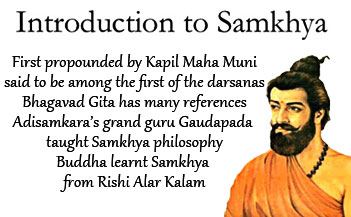
Sankhya-Karika is a clear composition with many practical examples. Besides, commentaries were also written on the Karika. Some commentaries are VacaspatiMishra’s-Sankhya-Tattva- Kaumudi and Vijnana Bhikṣu’s Sankhya-Pravacana-Bhaṣya.
What is Sankhya Philosophy?
Like the Jain and Nyaya’s philosophy, Sankhya also has its own viewpoint on the evolution of mankind and the creation of the world. By far, Sankhya has been the most practical and intellectual in its approach towards metaphysics. Let’s understand the Sankhya Philosophy with regard to dual realism, causality, and evolution.
Dual Realism
According to Sankhya, dual realism answers the question – ‘Who is responsible for creating the world?’ Sankhya states there are are two layers of creation – one is Prakriti, the other one is Purusha. Prakriti refers to the smallest matter which constitutes each and every object in the world. Water, air, trees, leaves, mountains, houses everything is made up of matter. This matter is non-perishable. It does not have a beginning and an end. You can’t count Prakriti but you can count the objects that it is part of. For example, you can count trees or birds, but you can’t count the environment. It cannot be seen with naked eyes but it can be felt through its objects.
The second realism Sankhya talks about is Purusha – Purusha is eternal. It is neither the body nor the intellect. It can be described as pure consciousness. Purusha is the basis of all knowledge.
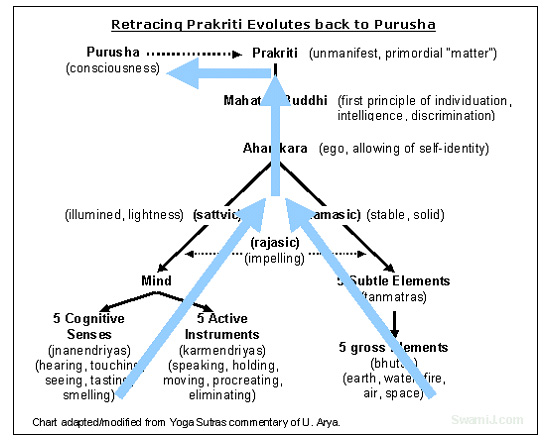
Hence, the dual realism of Sankhya is the existence of Prakriti and Purusha. Moreover, it is Prakriti which leads to the creation of the universe.
Causality
The dual realism talks about two levels of reality – Prakriti and Purusha. Prakriti is the cause of creation of every object on the earth. Hence, the effect is the object itself. For example, if there is a piece of wooden furniture, wood is the cause and the furniture itself is the effect. Hence, the causality theory says that each and everything we see in the universe is an effect(object) that results due to a cause(Prakriti).
In short, the theory of causation( Satkaryavada) states Prakriti is the ultimate cause of all creation – gross elements like body as well as subtle elements like Wisdom and Intellect. In addition, every cause has an effect. Moreover, this cause-effect relation leads to all sorts of creations in the cosmos and all objects are bounded by it.
Evolution
The theory of evolution states that Purusha and Prakriti come together and creates all objects in the cosmos. Purusha is eternal, it is the basic knowledge. It is a male, while Prakriti is the female component. When both of them combine, it leads to the creation of objects. Purusha by itself cannot be the cause of any object. Instead, it helps Prakriti in the creation. The main features of Sankhya evolution are:
- Prakriti has no beginning and no end. It is the ultimate cause of the creation of the universe.
- Prakriti, itself is uncaused, it’s eternal.
- It not only creates the gross elements like wood, body, stem but also subtle elements like intellects and speech.
- You can see Prakriti through its effects.
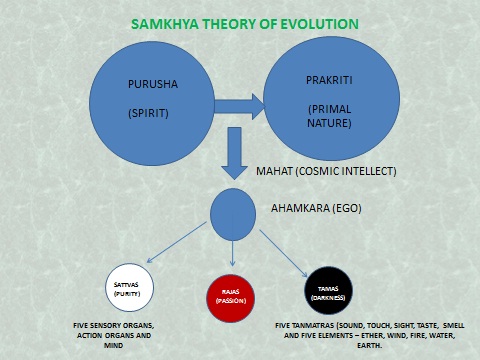
Sankhya Philosophy And Education
This philosophy has greatly contributed to the understanding of the environment and living beings in relation to the environment. In fact, the three main thoughts propounded by the Sankhya philosophy finds its relevance even in modern science.
Therefore, you can say that Sankhya Philosophy in education is equal to Pythagoras in Geometry.
Elements of Sankhya Philosophy
The 24 elements which define the Sankhya philosophy are:
- Prakriti, Nature
- Mahat, the great principle
- Buddhi, discriminating, reasoning and causative intelligence
- Ahamkara, ego or ego-principle
- Manas, the physical mind or brain
- Five panchendriyas, sense organs.
- The five karmendriyas, the organs of action.
- Five
tanmatras , subtle elements - Lastly, five Mahabhutas or Pancha Bhootas.




